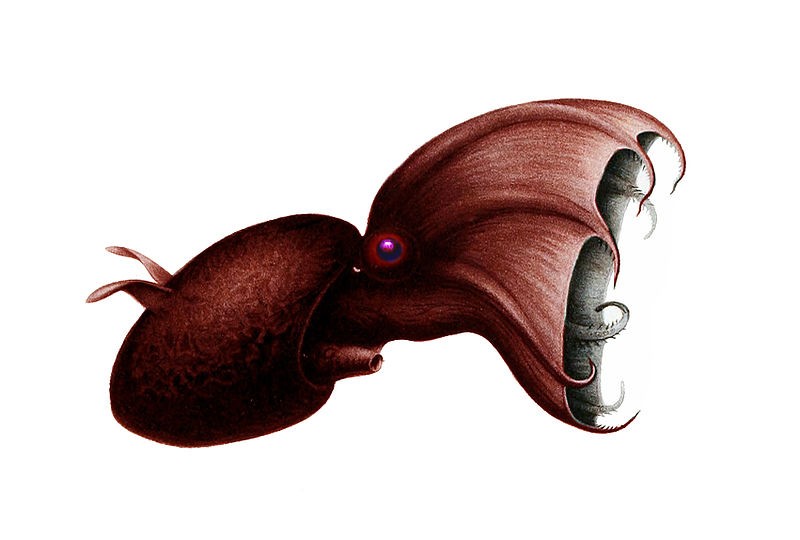A dangerous 'vampire' predator that lurked in Earth's waters more than 160 million years ago most likely did, in some ways, suck its prey.
Ancient Relative

Vampire Squid
A recent study of extremely well-preserved fossils of Vampyronassa rhodanica, a tiny mollusk related to current vampire squids (neither vampires nor squids), reveals the existence of muscular suckers used for snaring and manipulating food.
In other words, it was a predator on the go, scouring the pelagic depths for delectable morsels.
This is in stark contrast to the animal's closest cousins, Vampyroteuthis infernalis, whose suckers appear to be essentially inactive and which capture floating flakes of organic material utilizing adhesive cells on a pair of specialized, thread-like appendages.
"The difference in trophic niches between the two taxa is consistent with the hypothesis that these forms diversified in continental shelf environments before the appearance of adaptations in the Oligocene leading to their modern deep-sea mode of life," writes a team of researchers led by Sorbonne University, paleontologist Alison Rowe.
Also Read: Scientists Exploring Shipwreck Discover Mysterious 'Larger Than Human' Deep-Sea Creature
An Extremely Rare Fossil
Mushy creatures, such as cephalopods, are rare in the fossil record. Soft tissues do not fossilize as rapidly or as well as bones, making fossils, particularly excellent fossils, extremely rare.
Rowe and her colleagues investigated three V. rhodanica fossils from a lagerstätte (sedimentary deposit) going back to more than 160 million years ago in La Voulte-sur-Rhône, France. This highly fine sedimentary fossil bed is very effective at retaining fossils, especially soft tissue.
Even soft tissue kept in this manner is not always simple to decipher. Rowe and her colleagues brought the fossils to the European Synchrotron Radiation Facility in France for non-invasive 3D imaging to better understand the anatomy of V. rhodanica.
"The fossils are on little slabs that are difficult to scan," Rowe says.
"On top of that, soft tissues are preserved, but we needed phase contrast imaging to visualize the faint density variation in the data, so ESRF beamline ID19 coherence was critical to perform propagation phase-contrast computed-tomography and track all the minute details, such as suckers and small fleshy extensions called cirri."
Analysis Result
The scans showed fascinating distinctions between V. rhodanica and V. infernalis; the Vampyromorph order's only surviving member.
Both have oval bodies bordered by two little fins and are quite small (the former is just 10 centimeters or 4 inches long). Both have tiny, fleshy projections called cirri that protrude from their arms.
However, no thread-like food snares were found on any of the V. rhodanica fossils, just an extended pair of arms with a distinctive arrangement of suckers.
It has more strength, muscular cirri, and suckers on the ends of these two specialized dorsal limbs. V. infernalis has smaller cirri, and its suckers only develop on the ends of its limbs farthest from its body. Furthermore, they appear passive and are not used to gripping prey.
"We hypothesize that the shape and positioning of V. rhodanica suckers and cirri in the differentiated arm crown enabled V. rhodanica to boost suction and sensory potential over the contemporary form, allowing them to manage and keep prey," Rowe adds.
In other words, V. rhodanica has the tools to be a pelagic predator, with more sensitive sensory organs and the capacity to grab prey. V. infernalis is calmer and more opportunistic.
Despite their kinship, the two species occupy distinct ecological niches... Neither of which has anything to do with vampires. Oh well.
Sea Monsters
Vampire squids were already lurking in the depths some 30 million years ago, waiting for biological detritus to drop down into their greedy arms.
They underwent a profound lifestyle shift for millions of years. If the fossils can be identified, researchers must figure out how and why this happened.
Related Article: Monstrous Underwater Scorpion Fossil Discovered by Researchers in Australia
For similar news, don't forget to follow Nature World News!
© 2024 NatureWorldNews.com All rights reserved. Do not reproduce without permission.



![Climate Change is Reducing Dust Levels Worldwide as Arctic Temperature Warms [Study]](https://1471793142.rsc.cdn77.org/data/thumbs/full/70320/280/157/50/40/climate-change-is-reducing-dust-levels-worldwide-as-arctic-temperature-warms-study.jpg)

